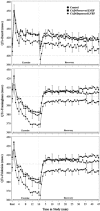Recovery of heart rate variability and ventricular repolarization indices following exercise
- PMID: 23094881
- PMCID: PMC3481193
- DOI: 10.1111/j.1542-474X.2012.00527.x
Recovery of heart rate variability and ventricular repolarization indices following exercise
Abstract
Background: There is a heightened risk of sudden cardiac death related to exercise and the postexercise recovery period, but the precise mechanism is unknown. We have demonstrated that sympathoexcitation persists for ≥45 minutes after exercise in normals and subjects with coronary artery disease (CAD). The purpose of this study is to determine whether this persistent sympathoexcitation is associated with persistent heart rate variability (HRV) and ventricular repolarization changes in the postexercise recovery period.
Methods and results: Twenty control subjects (age 50.7 ± 1.4 years), 68 subjects (age 58.2 ± 1.5 years) with CAD and preserved left ventricular ejection fraction (LVEF), and 18 subjects (age 57.6 ± 2.4 years) with CAD and depressed LVEF underwent a 16-minute submaximal bicycle exercise protocol with continuous ECG monitoring. QT and RR intervals were measured in recovery to calculate the time dependent corrected QT intervals (QTc), the QT-RR relationship, and HRV. QTc was dependent on the choice of rate correction formula. There were no differences in QT-RR slopes among the three groups in early recovery. HRV recovered quickly in controls, more slowly in those with CAD-preserved LVEF, and to a lesser extent in those with CAD-depressed LVEF.
Conclusion: Despite persistent sympathoexcitation for the 45-minute recovery period, ventricular repolarization changes do not persist for that long and HRV changes differ by group. Additional understanding of the dynamic changes in cardiac parameters after exercise is needed to explore the mechanism of increased sudden cardiac death risk at this time.
© 2012, Wiley Periodicals, Inc.
Figures




Similar articles
-
Persistent sympathoexcitation long after submaximal exercise in subjects with and without coronary artery disease.Am J Physiol Heart Circ Physiol. 2011 Sep;301(3):H912-20. doi: 10.1152/ajpheart.00148.2011. Epub 2011 Jun 10. Am J Physiol Heart Circ Physiol. 2011. PMID: 21666114 Free PMC article.
-
QT-RR hysteresis is caused by differential autonomic states during exercise and recovery.Am J Physiol Heart Circ Physiol. 2012 Jun 15;302(12):H2567-73. doi: 10.1152/ajpheart.00041.2012. Epub 2012 Apr 27. Am J Physiol Heart Circ Physiol. 2012. PMID: 22542617 Free PMC article.
-
Assessment of cardiac autonomic regulation and ventricular repolarization after off-pump coronary artery bypass grafting.Heart Surg Forum. 2006;9(3):E661-7. doi: 10.1532/HSF98.2006-1020. Heart Surg Forum. 2006. PMID: 16753938 Clinical Trial.
-
QT dispersion and heart rate variability in sudden death risk stratification in patients with ischemic heart disease.Medicina (Kaunas). 2006;42(6):450-4. Medicina (Kaunas). 2006. PMID: 16816538 Review.
-
QT dynamics and variability.Ann Noninvasive Electrocardiol. 2005 Apr;10(2):256-62. doi: 10.1111/j.1542-474X.2005.10205.x. Ann Noninvasive Electrocardiol. 2005. PMID: 15842438 Free PMC article. Review.
Cited by
-
Heart Rate Variability Correlates to Functional Aerobic Impairment in Hemodialysis Patients.Arq Bras Cardiol. 2015 Jun;104(6):493-500. doi: 10.5935/abc.20150039. Epub 2015 May 5. Arq Bras Cardiol. 2015. PMID: 26131705 Free PMC article.
-
Caffeine increases performance and leads to a cardioprotective effect during intense exercise in cyclists.Sci Rep. 2021 Dec 21;11(1):24327. doi: 10.1038/s41598-021-03158-2. Sci Rep. 2021. PMID: 34934054 Free PMC article. Clinical Trial.
-
Caffeine affects autonomic control of heart rate and blood pressure recovery after aerobic exercise in young adults: a crossover study.Sci Rep. 2017 Oct 26;7(1):14091. doi: 10.1038/s41598-017-14540-4. Sci Rep. 2017. PMID: 29075019 Free PMC article. Clinical Trial.
-
Beetroot Juice Produces Changes in Heart Rate Variability and Reduces Internal Load during Resistance Training in Men: A Randomized Double-Blind Crossover.Nutrients. 2022 Dec 2;14(23):5119. doi: 10.3390/nu14235119. Nutrients. 2022. PMID: 36501148 Free PMC article. Clinical Trial.
-
Oral adenosine 5'-triphosphate supplementation improved hemodynamic and autonomic parameters after exercise in hypertensive women.J Exerc Rehabil. 2018 Aug 24;14(4):671-679. doi: 10.12965/jer.1836256.128. eCollection 2018 Aug. J Exerc Rehabil. 2018. PMID: 30276192 Free PMC article.
References
-
- Mittleman MA, Maclure M, Tofler GH, et al. Triggering of acute myocardial infarction by heavy physical exertion. Protection against triggering by regular exertion. Determinants of Myocardial Infarction Onset Study Investigators. N Engl J Med. 1993;329:1677–1683. - PubMed
-
- Albert CM, Mittleman MA, Chae CU, et al. Triggering of sudden death from cardiac causes by vigorous exertion. N Engl J Med. 2000;343:1355–1361. - PubMed
-
- Mittleman MA, Siscovick DS. Physical exertion as a trigger of myocardial infarction and sudden cardiac death. Cardiol Clin. 1996;14:263–270. - PubMed
-
- Cobb LA, Weaver WD. Exercise: A risk for sudden death in patients with coronary heart disease. J Am Coll Cardiol. 1986;7:215–219. - PubMed
-
- Siscovick DS, Weiss NS, Fletcher RH, et al. The incidence of primary cardiac arrest during vigorous exercise. N Engl J Med. 19844;311:874–877. - PubMed
Publication types
MeSH terms
Grants and funding
LinkOut - more resources
Full Text Sources
Medical
Miscellaneous

